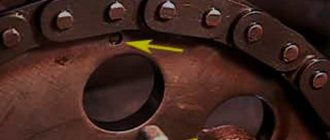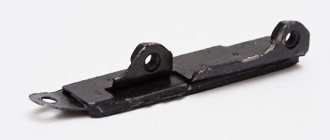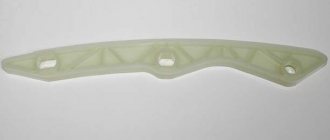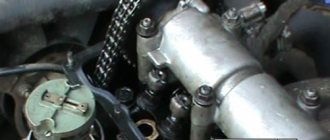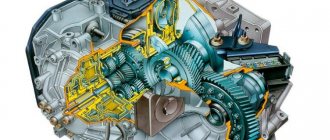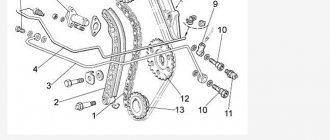The fairly technologically advanced and durable naturally-aspirated engine EP6, which is installed on a number of Peugeot models, including the 308, requires complex repairs from time to time. Without experience working with engines of this level and without the appropriate equipment, there is no need to talk about complex repairs. Nevertheless, replacing the timing chain on a Peugeot 308 with an EP6 engine is possible with your own hands. Before this, you need to know when to change, know where the installation marks are and how to correctly align the camshafts and crankshaft relative to each other. Let's try to figure this out.
Replacing the timing chain of Peugeot 308 ep6 1.6
The timing chain transmission lasts longer than the timing belt, but it also eventually exhausts its service life and has to be replaced.
Here we will talk about replacing the timing chain on a Peugeot E6 1.6. This procedure can be performed with your own hands, without the help of specialists. The timing chain has the same purpose as the belt - synchronizing the operation of the shafts. Synchronization allows the shafts to move without interfering with each other. If you imagine for a moment that the synchronization will be disabled, this will cause the pistons to meet the valves. Because of this, the valves will be bent, and the pistons will also receive severe damage. The advantage of a chain drive is that, although the chain can break, this happens extremely rarely; much more often the chain stretches. But since a break is still possible, the circuit must be monitored by periodically carrying out diagnostic procedures.
Consequences of wear
Over time, the chain's hinge joints wear out, causing it to stretch. The pitch between the links increases, and the consumable will no longer work efficiently. The chain needs to be changed in the following cases:
- it is no longer possible to adjust the chain tension;
- the marks on the shafts no longer match;
- chips or other damage are visible on the consumable.
If the chain stretches, the engine will run rough. It begins to make extraneous noises, making it harder to start. The car begins to consume more fuel. On a stretched chain, the links can slip over the teeth. It’s good if after this the car simply stops moving, but this may well cause the valves to meet the pistons, and this is a major repair. Therefore, it is always very important to regularly check the current condition of the consumable. Although a chain is more practical than a belt, it also wears out its resource. Chain transmission has its undeniable advantages:
- the chain rarely breaks, much more often it stretches;
- the chain is made of solid material;
- in case of interruptions in the operation of the circuit, the valves are not subject to external mechanical influence.
Replacing this consumable is not an easy task, which many car enthusiasts entrust to professionals, but you can carry out the replacement procedure yourself. To do this, you must follow the instructions exactly and try to do everything correctly.
Professional inspection of EP6 / EP6 TD engine belts at AvtoPSA
The problem with diagnosing the entire timing belt assembly is saving on diagnostic tools. Multi-brand gadgets connected to diagnostic lines only show generic codes that don't tell you much. A certified service center must “catch” specific errors, otherwise serious problems may arise. For example, from would-be repairmen you can hear a recommendation to replace the lambda probe, although in fact the car was giving signals precisely because the chain was highly stretched.
At AUTOPSA, owners of cars from the French concern can receive the following services:
- Firmware only with official diagnostic software from PSA. It is thanks to the programs that you can determine whether the timing rollers, chains, or both need to be changed. Versions of diagnostic software are always the latest and equivalent to the model being tested.
- Experienced technicians specializing in French cars will carry out the first visual diagnosis perfectly. It is no secret that the “French” have many non-trivial engineering solutions, as well as a rather non-standard arrangement of the car’s control electronics. Masters with twenty years of experience check everything personally and manually.
- Checking the deformation of parts of the timing belt assembly using high-precision diagnostic instruments. Such readings are guaranteed to provide readings on abrasion and deformation of belts and chains with an accuracy of almost hundredths.
Replacement process
It is better to carry out the chain replacement procedure on an overpass or using a jack. Here are the tools you will need:
You should buy only high-quality materials. There is no need to skimp on consumables. When buying a chain, look at its sag - a new consumable will not sag more than 10 mm. The quality of the material from which the consumable is made can be checked with a needle file.
- So, first we lift the car with a jack. Then we de-energize it by disconnecting the negative terminal from the car.
- We dismantle the front wheel on the right and the fender liner.
- Remove the air filter by disconnecting the air pipe.
- Remove the casing from the engine.
- Disconnect the camshaft motion sensors.
- We dismantle the ignition coils, disconnecting the power from them.
- Disconnect the ventilation hose with all pipes. Don't forget to install plugs to prevent dirt from getting in.
- Remove the cylinder block cover.
- Now you need to slightly raise the engine and remove the dipstick.
- Remove the engine mount.
- We dismantle the additional drive belt. units.
- We remove the additional pulley. equipment, for which you will have to unscrew 3 screws.
- Scroll the crankshaft to the flywheel locking position.
- We fix the flywheel and shafts. To do this, you need to use a special device.
- Remove the chain tensioner.
- We remove all the pulleys.
- Remove the crankshaft hub.
- The next step is to remove the timing chain itself.
- Remove the tensioner guides.
- Remove the crankshaft gear.
- Before putting new consumables into place, the seats must be thoroughly cleaned of dirt.
- Now we assemble all the guides, the chain and install it all.
- We set all the necessary tags.
- We place the timing gear pulley on the crankshaft.
- Install the crankshaft hub.
- We put all the pulleys in their places.
- We install the tensioner and dampers.
- We install the seal ring.
- Install the additional drive pulley. equipment.
- We put on the belts of additional units.
- We install the oil dipstick and all pipes.
- We put the motor casing and pipes in place.
- Now we install the wheel.
As you can see, although this is quite difficult work, it is still doable. If all necessary conditions are met, it is possible for anyone to do it. Upon completion of assembly, be sure to check the operation of the engine. If there is any extraneous noise, the installation procedure will have to be repeated.
Replacement procedure
To work, you need a set of tools with which to fix the shafts, set marks, adjust the degree of chain tension and valve timing. Such a kit with a tensioner testing device costs about 7-8 thousand rubles (Likota, JTC).
The value is checked by inserting a device in place of the chain tensioner, and the gap is measured:
Permissible chain tension indicators:
- 69-73.5 mm – for naturally aspirated engine EP 6
- 67-70 mm – for turbocharged diesel versions.
New timing chain kit includes:
Before work, the car is placed on a lift, or the front part is jacked up, the front wheels and the negative terminal are removed from the battery. Replacement instructions:
- Remove the engine air filter, move the pipes to the side:
- Remove the valve cover, disconnecting the sensors:
- Unscrew the cover fastening bolts:
- Using a wrench and a socket set to “18”, turn the camshafts until the marks completely coincide. Attention: it is necessary to rotate only as work progresses - if it was not possible to install it the first time, then rotate the shafts to a full revolution.
- The flywheel should be fixed using the special tool from the kit. Next, install the distribution phase marks:
- Remove the oil dipstick and unscrew the engine mount mounting, slightly lifting it on the stop. Fix the marks with a special tool:
- Next, unscrew the tensioner screw and remove the timing chain:
- Dismantle the timing components in the following sequence: upper stabilizer, intake/exhaust valve mounts and crankshaft hub cover. Then we remove all the mechanisms:
- Installation of a new chain is carried out in the reverse order, and it is necessary to ensure that the installation marks are fixed according to the markings: exhaust - EX30, inlet - IN Both side stabilizers are installed simultaneously with the flywheel and sprockets, after which the chain is secured and the tension is adjusted:
Before installation, it is necessary to clean all components from dirt, treat them with lubricants, and treat the tensioner bolt with fixing sealant. If all work is carried out according to the instructions, then the installation marks should match and the engine will start. After starting the unit, you should let it idle for 5-10 minutes, ensuring that the timing belt operates correctly.
Replacing the timing chain on Peugeot 308 1.6 EP6 and EP6TD at the FransAvto technical center.
The Peugeot 308 timing chain is an important component under the hood of the car. If you do not replace it with a new one in time, unpleasant consequences are possible. Because The head valves may be damaged, which entails high repair costs. How can you determine its wear? First of all, monitor the car’s mileage; if it has exceeded more than 60,000 kilometers, you should pay more attention to every sound. If the idle speed begins to float, the engine does not operate evenly in cold weather, and the “Antipollution faulty” error appears on the dashboard or fuel consumption increases. Most likely the cause is a stretched timing chain. In this case, we advise you to go to a service center and get a diagnosis.
The cost of replacing the chain in our technical center.
Standard chain replacement for Peugeot 308 1.6 EP6 work with spare parts price: 15,000 RUR
The kit includes:
- Job
- Timing chain 9822827080
- Chain tensioner 9816058580
- Upper chain stabilizer 081841
- Chain guide 2 pcs. 081833/081840
- Front crankshaft oil seal 0514C8
- Valve cover gasket (kit) 0249F4
- Crankshaft gear 0513C8
- Bolts 3 pcs. 082026*2/082027
Complete replacement of the timing chain for Peugeot 308 1.6 work with spare parts price: 24,000 rub.
The kit includes:
- Job
- Timing chain 9822827080
- Chain tensioner 9816058580
- Upper chain stabilizer 081841
- Chain guide 2 pcs. 081833/081840
- Front crankshaft oil seal 0514C8
- Valve cover gasket (kit) 0249F4
- Crankshaft gear 0513C8
- Exhaust camshaft gear (variable exhaust valve timing clutch) 0805K1
- Intake camshaft gear (intake variable valve timing clutch) 0805K2
- Bolts 3 pcs. 082026*2/082027
You can get advice or sign up for repairs and maintenance by calling us at +7(495)507-26-33 . Call!
The address of our technical center where we replace chains for Peugeot and Citroen.
Replacement algorithm
Now we’ll tell you in detail how to replace the timing chain on a Peugeot 308 EP6. When you have prepared everything you need, you can begin the repair, for this:
- Remove the air purification filter and carefully move the pipes to the side.
- Remove the plastic cover and disconnect the camshaft sensors. Remove the valve cover.
- Rotate the crankshaft until the marks on the camshafts match. You cannot rotate the crankshaft in the opposite direction; it is better to make two turns clockwise.
- Install the lower marker and secure the flywheel.
- Remove the oil dipstick and loosen the engine mount. After this, you can raise the engine a little. Without this, it will not be possible to replace the chain on the Peugeot 308 EP6.
- Install the upper device for fixing the camshaft marks.
- Remove the alternator belt.
- Remove the three bolts that secure the fluid pump drive roller.
- Remove the tensioner and upper damper.
- Remove the sprocket bolt on the exhaust and intake camshafts. Be careful not to let the sprocket fall into the crankcase.
- Install the front attachment using the mounting bolt and put the chain on it.
- Remove the bolts that secure the crankshaft hub cover.
- Remove the hub and take out the chain with the left and right guides.
- Remove the oil seal and timing gear.
That's it, dismantling is complete. Before installing a new kit, you need to wash the crankshaft hub and sprocket with any degreaser. As you can see, replacing a Peugeot 308 chain with your own hands is not very difficult. But you will have to fork out for a set of accessories.
What needs to be done to replace the chain on a Peugeot 308.
After preparation, it is necessary to de-energize the car’s electrical system by removing the terminals from the battery. Next, remove the engine protection, the right front wheel, remove the air filter and fender liner. For safety, after disconnecting the pipes, cover them with a rag to prevent unnecessary objects from getting in. Then you need to remove the spark plugs to lighten the crankshaft. And finally the valve cover. Before changing the timing chain, be sure to mark the sprocket and camshaft adjuster.
Recommendations for perfect operation of the timing chain on a Peugeot 308
- First of all, change the oil on time.
- Monitor the engine oil level.
- Use original Total oils.
- Refuel with quality fuel.
- Carry out maintenance on time.
These tips, although simple, will save a decent amount.
As you can see, replacing a timing chain is not something everyone can do. If you have any problems with this, we are ready to help you and do all the replacement work for a small price. Our headquarters employs highly qualified craftsmen who will provide comprehensive advice.
Make an appointment to replace the timing chain of Peugeot 207, 308, 508 and Citroen C3, C3 Picasso, C4 Picasso, C4, DS3, DS4, DS5 right now:
Video
The video from the Auto Repair channel clearly demonstrates the entire process described above.
Do you have any questions? Specialists and readers of the AUTODVIG website will help you ask a question
Was this article helpful?
Thank you for your opinion!
The article was useful. Please share the information with your friends.
Yes (100.00%)
No
X
Please write what is wrong and leave recommendations on the article
Cancel reply
Rate this article: ( 3 votes, average: 5.00 out of 5)
Discuss the article:
Replacing the timing chain of Peugeot 308 EP6 engine
The owner of a “Frenchman” with an EP6 engine turned to the specialists of the 500 Ampere service station for help with complaints about reduced engine power, unstable speed, interruptions in operation and extraneous noise, and increased oil consumption. According to the client, his Peugeot 308 needed a chain replacement.
In order to provide its products with innovative engines with variable valve timing, the PSA concern built a pair of EP6 gasoline engines every minute. Their characteristics are impressive. Efficiency, environmental cleanliness of the exhaust and acceleration dynamics continue to please owners throughout the entire warranty period.
Unfortunately, the reliability of the “latest technology” was not up to par. Engines are extremely sensitive to the cleanliness and quality of engine oil. Many owners complain about the characteristic “diseases” of the EP6, associated with malfunctions of both the entire gas distribution mechanism and its individual components. Often problems arise almost immediately after the factory warranty expires.
Initially, the manufacturer calculated that the engine could “run” 20 thousand kilometers without changing the engine oil. Life has forced us to tighten the recommendations twice, but, as practice shows, even 10 thousand is a lot for EP6. Experienced owners say that the oil should be changed along with the air filter, approximately every 6-8 thousand kilometers. At the same time, it would be a good idea to flush the injectors. Saving on replacement risks premature repair of the gas distribution mechanism, which will cost much more.
Unfortunately, timely replacement of engine oil alone is not enough for a fastidious engine. Quality plays a huge role. You can argue about the disadvantages and advantages of this or that “synthetics”, but operating experience puts an end to all disputes. The only engine oil that EP6 views favorably is Total Ineo ECS 5W30. It was developed specifically for Peugeot and Citroën, which obviously explains the exact match between the characteristics of the oil and the needs of the engine.
During long-term operation, carbon deposits accumulate in the engine oil, which is then deposited in problem areas, causing malfunctions. Due to deposits, the return springs of the gears of the phase rotation mechanism stick, disrupting the operation of the timing belt. The fault can only be eliminated by replacing the gears.
Carbon deposits accelerate the wear of valve stem seals, the service life of which is already short. The oil leaking down the rods burns in the cylinder, forming a strong coke layer on the surface of the seat and valve.
Malfunction of the caps manifests itself in increased consumption of engine oil, but often owners “don’t bother” with minor repairs and do not pay attention to the problem, adding oil as needed. As a result, the carbon layer grows, due to the thickening the valve drops too low, and the hydraulic compensators cannot cope with the increased clearance. In response, the motor indignantly rattles its “fingers” like a bucket of nuts. The only way to eliminate the problem is to “halve” the engine, manually clean off the debris and grind the valves.
VTi technology, implemented in the design of EP6 engines, “can” not only shift the valve timing, carefully selecting the most appropriate moment for valve actuation, but also regulate the degree of their opening. The on-board computer controls this complex process. Based on his commands, the stepper motor adjusts the position of the valve rods through a worm gear.
This mechanism is an additional source of headache for the owner who does not pay enough attention to engine oil. Due to poor lubrication, the servo drive quickly wears out, which not only affects the valve position, but also creates an extra load on the electric motor, stimulating premature failure.
The most common cause of a malfunction of the phase shift system is the failure of the control solenoid valves, which disrupts the oil supply to the phase change mechanism. You can check their operation only by replacing them with known good ones. Fortunately, the operation is simple and takes no more than 10 minutes.
Another possible reason for the lack of oil in the phase change mechanisms is the deterioration of the o-rings, camshaft caps or beds in the cylinder head. It is not difficult to replace the seals; in other cases - when the lids or beds suffer - you have to change the head.
A “disorder” of the timing system may occur due to wear of the drive. A single-row chain often stretches, its resource is limited, as is the resource of plastic parts, which sometimes break, even if everything is in order with the chain. During operation, not only the chain is replaced, but the entire drive complete with stabilizer, tensioner, guides, gears and crankshaft oil seal.
Computer diagnostics of the EP6 motor that came in for repair revealed error P0014 associated with malfunctions in the phase change mechanism. Replacing the control solenoid valves did not affect engine operation. The service station specialists came to the conclusion, confirming the owner’s assumption, that the performance characteristics of the EP6 would be restored by replacing the timing chain along with other drive parts and gears.
To replace the Peugeot 308 chain and preparatory operations, in addition to the usual set of keys and heads with radial TORX slots, a tension simulator, special devices for fixing the crankshaft and camshafts, and an inclinometer to control the angles of camshafts were used. During repairs, original spare parts were installed to replace failed parts.
Changing the timing chain on a Peugeot 308 EP6 with your own hands: when to change, video inside
The fairly technologically advanced and durable naturally-aspirated engine EP6, which is installed on a number of Peugeot models, including the 308, requires complex repairs from time to time. Without experience working with engines of this level and without the appropriate equipment, there is no need to talk about complex repairs. Nevertheless, replacing the timing chain on a Peugeot 308 with an EP6 engine is possible with your own hands. Before this, you need to know when to change, know where the installation marks are and how to correctly align the camshafts and crankshaft relative to each other. Let's try to figure this out.
Timing chain selection: original and analogues
Engines of the EP 6 type are installed on Peugeot, Citroen and Mini-Cooper cars in different generations; their analogue timing chain kits are also suitable for a certain type of unit. When choosing, take into account the catalog number and article number, which corresponds to the VIN of the car.
The price of analog sets may vary depending on the brand and country of manufacture. When purchasing, pay attention to the full labeling of the product, which should have a barcode of the country of manufacture, an article number, and pictograms of OE and EU certificates of conformity. Counterfeit kits made in China that do not have a brand license are often passed off as analogues.
When to change the timing chain on a Peugeot 308 (regulations and signs of replacement)
Despite the fact that externally the drive chain of the naturally aspirated EP6 gas distribution mechanism looks flimsy, it is capable of working properly for at least 150-170 thousand if you take good care of the engine and comply with technical regulations . The same applies to the timing chain for this engine with a turbine, and the replacement process differs little. The difference lies in some nuances in the replacement and adjustment process, as well as wear tolerances.
The timing chain is capable of running 150-170 thousand km.
A break in the drive chain is unlikely, so replacing it is only considered if certain symptoms, sometimes indirect, appear.
Indirect symptoms
The main ones are considered:
- Increased “diesel” noise when the engine is running at idle and low speeds.
- The engine starts to stall and has trouble starting.
- Oil consumption is increasing at a rate of 0.25-0.5 liters per 1000 km, and high gasoline consumption is observed.
- Unstable operation, failures, the engine suddenly stalls.
- The on-board computer may display the Antipollution system faulty error and a number of profile errors related to the gas distribution system.
The Antipollution system faulty error may indicate problems with the timing chain.
There may be even more symptoms, but the main reason for replacing the chain is the corresponding mileage, especially in cases where the car is used in the city, where the mileage is about two kilometers.
When is replacement needed?
Despite the rather flimsy appearance of the timing chain, it has a long service life. On atmospheric EP6 engines it lasts for about 170 thousand km. But this is subject to the condition that all technical regulations will be unquestioningly observed, and the attitude towards the engine will be as careful as possible. But even if the engine is not naturally aspirated, but with a turbine, the timing drive lasts about the same. But there are minor nuances when diagnosing the condition of the timing chain; we will definitely mention this in our article.
The repair procedure is no different for naturally aspirated and turbocharged types. It is worth noting that a break is unlikely to occur, so replacement should only be carried out if certain symptoms are present, which are sometimes quite difficult to identify. Now we will look at all the symptoms that indicate that the timing drive needs to be repaired.
Checking chain wear
Before starting the job of replacing the timing chain with your own hands, you need to make sure that the chain has served its purpose. This is due to the fact that wear symptoms may indicate other breakdowns and malfunctions of the systems and may not be related to the timing belt. To check wear and replace the drive chain, you need to buy a set of special devices (Likota, JTC) . Without this kit, it is impossible to check and align the camshafts and crankshaft exactly to the marks, as well as adjust the VTi phase adjustment mechanism. The whole set costs about 7-8 thousand and includes a device for checking the degree of chain stretch.
Set of shaft clamps and drive chain tensioner.
The device is a complex threaded bushing that is screwed in instead of the standard tensioner. First, screw in a large threaded bushing without using keys, by hand. The rod is screwed into this bushing until it stops, also only by hand. After this, the device is turned out of the socket and the length of the rod is measured from the beginning of the threaded part of the sleeve. The permissible chain stretch ratings are :
- for naturally aspirated engine EP6 - 70-73.5 mm ;
- for an engine with a turbine - from 67 to 71 mm .
Tools and necessary spare parts for replacement
If measurements show that the chain slack exceeds the nominal value, we prepare for replacement and buy spare parts according to the catalog numbers indicated in the table.
| Part name | Catalog no. |
| New timing chain, original | 0816-N9 |
| Intake camshaft toothed pulley (gear) | 0805-K1 |
| Exhaust camshaft toothed pulley (gear) | 0805-K3 |
| Two camshaft seals for intake | 0807-39 |
| Crankshaft toothed pulley (gear) | 0513-C8 |
| Two new disposable camshaft gear bolts | 0806-77 |
| Timing chain tensioner | 0829-G3 |
| Upper chain guide, original | 0 818-41 |
| Right chain guide | 0818-30 |
| Left chain guide | 0818-33 |
| Crankshaft hub | 0513-E1 |
| Crankshaft oil seal | 0514-C8 |
| Crankshaft hub fixation bolt, disposable | 0516L8 |
| Valve cover gasket | 0249-E7 |
Depending on the condition of the engine, other fasteners and wear parts may be needed. Here is a list of tools, not including a set of special devices :
- large and small ½ and ¼ collars;
- standard set of heads;
- set of Torex attachments;
- torque wrench;
- locking (locking) sealant;
- sealant for gaskets;
- Screwdriver Set.
When should you change?
The timing chain drive (gas distribution mechanism) of the 1.6-liter Peugeot 308 16v gasoline engine is quite durable and there have been cases where the chain lasts up to 150 thousand km. However, such a resource is possible only under the condition of careful operation of the engine and compliance with maintenance regulations. In practice, the Peugeot 308 timing chain is replaced at intervals of 60 thousand kilometers. When the chain wears out, it lengthens, which causes a shift in valve timing.
The recommended belt replacement interval for a Peugeot diesel engine is 240 thousand km or 10 years of operation. In fact, replacement is carried out more often - usually after 100 thousand km.
The main signs of wear on the timing drive will be:
- noisy engine operation at low speeds, reminiscent of a diesel engine;
- difficult starting and increased fuel consumption;
- the appearance on the on-board computer screen of errors related to the operation of the gas distribution system.
A chain sagging under the guide is a sign of the need for replacement.
Consequences of untimely replacement
If any of the symptoms mentioned above appear, it is necessary to check the condition of the timing drive. Since further operation of an extended chain can lead to a major overhaul of the engine. A stretched chain can jump over several gear teeth and the engine valves will collide with the piston heads. In this case, repairs will be long and expensive.
Checking chain wear
The petrol engines of the EP6 and EP6DT Turbo models used in the Peugeot 308 have the ability to check chain wear using a special tool. Such a tool is, for example, a set of clamps for various engines of the Peugeot-Citroen concern from the Likota company (catalog number ATA-3805). The kit includes a special template with a threaded part, which is installed in place of the standard chain tensioner. The rod from the kit is screwed into the template. Chain wear is determined by the length of the rod and bushing; the measurement process is shown in the photo.
For a naturally aspirated engine, the length of the rod and sleeve should not exceed 73.5 mm, for a turbo engine - no more than 71 mm.
How to replace the timing chain on a Peugeot 308 with your own hands
Despite all the reliability and manufacturability of the naturally aspirated EP6 engine that powers the Peugeot 308, it sometimes requires repairs. The high complexity of the design does not allow many components to be repaired at home, so most often the owners of such cars turn to specialized services if any problems arise. However, such a simple task as replacing the timing chain on a Peugeot 308 with an EP6 engine can be done independently - just strictly follow the instructions in this article.
Tightening torque and reassembly
As you can see, on an ep6 motor, replacing the chain is a complex procedure, but it requires special tools and skills. It is also important to know with what torque (force) to tighten previously unscrewed bolts. This information is in the manual, it is recommended that you read it before starting assembly.
For example, the tightening of the chain tensioner with a torque wrench is 8.5 da.N.m, the stabilizer bolts are 2.5, the crankshaft hub mounting bolt is 5, the attachment pulley bolts are 2.8, the phase shifter mounting bolt is 2, the camshaft sprocket is 2, etc.
We also recommend reading the article about which drive is better, a timing chain or a belt. In this article you will learn about the advantages and disadvantages of various types of timing gear drives.
It is also recommended to lubricate the crankshaft sprocket mounting bolt with so-called liquid fixative. It is also important not to make mistakes when installing phase shifters on the intake and exhaust shafts (the intake is marked IN35, the exhaust is EX30).
Indirect signals about the need for replacement
The timing chain itself is a much more reliable consumable than a belt, and can withstand a mileage of more than 150 thousand kilometers if you treat the car with care and follow all technical regulations prescribed by the manufacturer in the instructions. This applies not only to naturally aspirated, but also to turbocharged versions of this car.
The following symptoms most often indicate the need to replace the chain:
- Unusual engine noise, reminiscent of a diesel engine, when idling or at low speeds.
- Troubling, engine operation with failures and sudden shutdowns.
- Problems starting the engine.
- Oil is consumed in volumes exceeding standard values, and fuel consumption increases.
The message “Anti-pollution system faulty” or other errors appear on the on-board computer screen, indicating problems in the operation of the gas distribution mechanism.
- The "Check Engine" signal appears.
When the timing chain wears out on a Peugeot 308, other problems are possible. You should pay special attention to them if the car has already accumulated the appropriate mileage and was operated in urban mode.
How to check chain wear?
To accurately determine that the timing chain on your Peugeot 308 requires replacement, you need to check its condition. To do this, you will need a specialized set of clamps, which includes devices that allow you to control wear in accordance with the regulations. It ensures precise alignment of the shaft to the marks and adjustment of the valve timing adjustment mechanism.
The main component of the kit is a threaded bushing, which is installed in place of the tensioner during testing. It must be screwed in by hand, without using keys or other tools, otherwise it will fit too tightly. Next, the rod is screwed into the bushing, this is also done manually. Then gently unscrew the device from the socket and measure the rod from the beginning of the thread on the sleeve.
For a working chain, the range of distances can be as follows:
If the chain sags more than the standard values, it must be replaced.
What is needed for replacement?
To replace the chain, you will need the following parts:
- New timing chain.
- Tensioner.
- Upper, right and left dampers.
- Camshaft and crankshaft gears.
- Sealing couplings for the camshaft inlet valve.
- Bolts for the camshaft gear.
- Hub, bolt for fixing the hub and crankshaft oil seal.
- Valve cover gasket.
This is a minimum set of parts; other consumables may also be required (if the engine is very worn).
In addition, you need to prepare a set of tools:
- 1/2 and 1/4 collars.
- Heads.
- Torex bits.
- Torque wrench.
- Screwdrivers.
- Retaining sealant and gasket sealant.
Once everything is ready, you can start making repairs.
Correct replacement and repair of the timing belt - guaranteed results
If it turns out that something needs to be changed in the unit, our mechanics will do the most diligent selection and adjustment of the units. In particular, we replace chains, tensioners, dampers, camshaft and crankshaft sprockets and bolts, all the necessary gaskets and seals. The work will be done on time, and the car will return to efficiency, dynamics, and factory power. You can sign up for diagnostics and replacement directly on the AutoPSA website, or by calling the number indicated there.
We also repair and replace cylinder head gaskets on EP6 engines.

